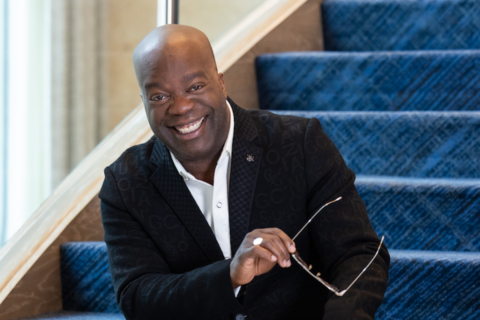If you want your customers to love you, you’ve got to love them first (right along with your own employees). Deb Boelkes explains how to create the kind of culture that shows your customers and employees just how much you care.
We don’t typically think of love and business as existing in the same universe. Not only does love belong in the business world, Deb Boelkes says, it should fuel everything you do, both internally and in interactions with customers.
“Your customers are the reason you exist, and your job is to earn their love and loyalty,” says Boelkes, author of The WOW Factor Workplace: How to Create a Best Place to Work Culture. “That means you must first love them. And that, in turn, means you must first love your employees.”
None of this will happen if you go through the motions. You can’t “fake” love for employees or customers. You must go all in. You must infuse love into all that you do. And that means building it in from the ground up.
Boelkes suggests the process start with a workplace in which heartfelt leaders inspire employees to create extraordinary products and deliver impeccable service at a great value. This creates an unparalleled experience for both employees and customers, and, in turn, makes them both feel special, appreciated, and respected.
A few tips for getting hearted (oops, we mean started):
1. Don’t be afraid to use the “L” word
In her book, Boelkes quotes the late Teresa Laraba, former vice president of Southwest Airlines, as saying, “Early on, when we started, one of the taglines was: Somebody up here loves you. We used the word love in a space where it had not been used, especially in the airline industry. Our stock symbol is LUV.”
“We were open about introducing love to corporate America and the airline industry. We were going to have a product which loved you and a company which was going to serve you and appreciate you doing business with us versus the attitude: ‘You exist to keep us in business.’”

“Find fun, creative ways to show the customer that you love them” suggests Boelkes. From personalized gifts to donations to worthy causes, in the name of your customers, “there are countless ways to show you care.”
2. Recommit to your relationship with employees
Engaged employees are happy employees, and happy employees create happy customers. That’s why successful leaders make it a priority to work on their relationship with employees. As with any strong relationship, “work” requires dedicated in time and effort.
Teresa Laraba said, “We do not subscribe to ‘you leave your problems at the door.’ You do, in the sense the customer shouldn’t have to pay for your employees’ problems, but as leaders you ought to know what’s going on with them and find out if there’s something that’s stopping your employees from delivering on their work promise that day.”
“If you don’t bother asking employees how they’re really doing except for every six months, or if you don’t stop to talk to them except once a year when you give them their performance appraisal, it is going to take too much time, because you’re trying to build a relationship in a ten-minute conversation when you should have been building a relationship every day.”
3. Think of yourself as a ‘superior service’ role model
If you commit to the best possible customer service and decision-making that benefits the customer first (both great ways to show you love them!), your employees will do the same. Employees watch leadership and taking cues from your behavior.
Boelkes says legendary coach John Wooden is a prime example. Wooden said, “I’m convinced that regardless of the task, leaders must be enthusiastic and really enjoy what they are doing if they expect those under their supervision to work near their respective levels of competency. With few exceptions, an unenthusiastic leader will keep those under his or her charge from achieving their collective best.”
4. Hire employees with a servant’s heart
Great leaders and employees alike develop what Teresa Laraba called a “Servant’s Heart.” She said, “We’re lucky at Southwest. We first try to hire people who care. Our hiring process is looking for people who genuinely enjoy what they do. We call it the Servant’s Heart. People who have a Servant’s Heart are people who, especially if you’re going to be on the service side of it, enjoy serving. Not somebody who merely pretends they enjoy serving.”
5. View your customers through ‘soft eyes’
Don’t treat customers like transactions. Boelkes quotes Howard Behar, former president of Starbucks Coffee: “I have this idea. Rather than seeing people as customers or seeing people in their roles as bankers or teachers or authors or whatever, we need to see all people in the context of their humanness, of being a human being. Then, when you’re dealing with somebody and whatever the job happens to be, whether you are trying to get a loan for your house or you are a banker trying to make a loan, you look at everybody through human eyes, through soft eyes.”
It means “you come at it with a caring attitude, with a belief in him or her as a human being and a belief in yourself as a human being. That piece of it only requires practice,” Behar clarifies. “We all get caught up in the transaction. We’re all in a hurry to get things done. Being in a hurry adds to it. Slow down. Take your time. Think about what you are doing.”
6. Create breathtaking service experiences
In her book, Boelkes cites her own experience with dining at Bern’s Steak House as one of her favorite examples of delightful customer service. She says the dining rooms were opulent. The menu was extensive and the food sublime. The Harry Waugh Dessert Room (and the lavish “Taste of Bern’s”—a sampling of five of their signature desserts) was spectacular. Finally, the wait staff was a testament to their mission to deliver impeccable service.
“We were so impressed with the service,” recalls Boelkes. “He never hovered, but magically appeared the instant we wanted him. When I asked how long he had been a waiter there, he answered, ‘two weeks.’ Given his professionalism, manners, attention to detail, and superior service attitude, this was a surprise!”
“We learned he had worked at Bern’s for two years. Everyone there starts out working in the kitchen. If they do well enough, they are promoted to assist in the dining room, and so on. Founder Bern Laxer was a firm believer in hiring for attitude and work ethic, not experience. Clearly, it pays off!”
7. Allow employees to serve customers in unique ways
Take a cue from Donald Stamets—general manager for Solage, an Auberge resort in Calistoga, CA—and don’t make employees ask permission to go the extra mile to serve customers.
As part of his Expected, Requested, and Delighted philosophy, Stamets encourages them to go above and beyond what the customer expects or requests and try to delight them at every turn. For instance, if a guest is sick, employees can bring them tissues and chicken soup without asking a manager.
“Likewise, tell your employees their goal is to delight customers,” says Boelkes. “Let them use their own judgment and tap into their creativity. Being allowed to do it ‘their way’ will encourage and inspire them to go in whole-heartedly.”
Love endures
The loving feeling you create between you and your customers will endure. “Yes, it’s hard work to be a heartfelt organization, but the rewards are so much greater for you, your team, and most of all, your customers,” says Boelkes. “Life is just better when you give and receive love every day, in all that you do. There’s no reason why this truth can’t apply to the workplace.”
Deb Boelkes is the award-winning author of The WOW Factor Workplace: How to Create a Best Place to Work Culture and Heartfelt Leadership: How to Capture the Top Spot and Keep on Soaring. She is not just a role model heartfelt leader; she’s the ultimate authority on creating best places to work, with 25+ years in Fortune 150 high-tech firms, leading superstar business development and professional services teams. As an entrepreneur, she has accelerated advancement for women to senior leadership. Deb has delighted and inspired over 1,000 audiences across North America.
© YFS Magazine. All Rights Reserved. Copying prohibited. All material is protected by U.S. and international copyright laws. Unauthorized reproduction or distribution of this material is prohibited. Sharing of this material under Attribution-NonCommercial-NoDerivatives 4.0 International terms, listed here, is permitted.










